What is SEO-driven content marketing and how to build one?

In today’s rapidly evolving digital landscape, the dynamics have shifted dramatically from what it was a decade ago — or even three years ago. This transformation directly responds to the rapid technological advancements and how businesses sell products and services to their customers.
So, what stands at the forefront of this evolution?
Content.
And the way we produce and consume it is in a constant state of flux.
Content is among one of the most crucial aspects of digital marketing. In today’s online world, content is the key to generating organic leads and establishing authority on important topics for your target audience. This, in turn, leads to a more refined pool of leads and increased sales. However, some organizations may still question the true significance of content. If we haven’t said it enough — it is more important than ever.
Approximately 90% of content remains invisible to Google’s search traffic. This implies that a mere 10% of content attracts 100% of the traffic. It is not merely about producing content; it’s about ensuring it captures Google’s attention above all else.
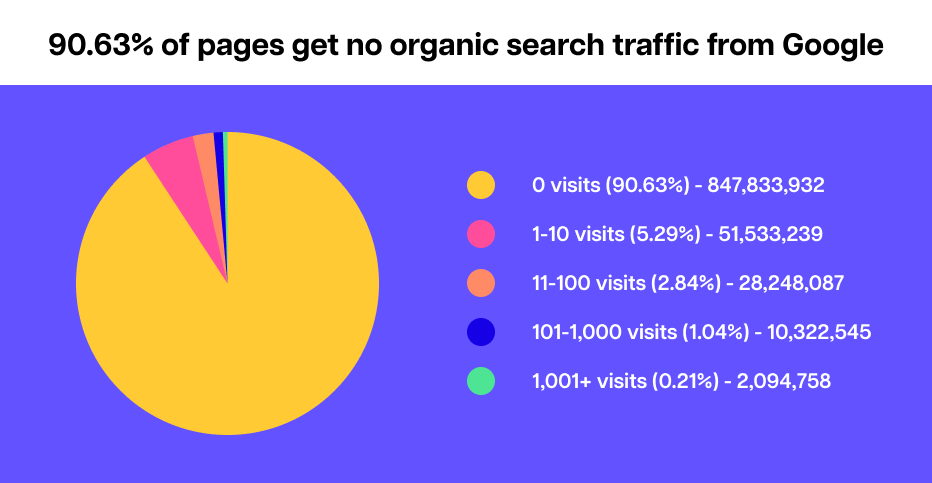
Put simply, the real value of content lies in its ability to attract customers with valuable information and insights that will drive business growth for years to come.
This is where a well-defined, SEO-driven content marketing strategy comes into the picture. But what is it and how do you build one? This article will explain everything you need to know about SEO-driven content marketing and how to use it to elevate your overall marketing efforts.
Defining SEO-Driven Content Marketing
SEO and content marketing are a dynamic duo, seamlessly complementing each other. They are, in essence, two sides of the same coin.
For optimal outcomes, you shouldn’t build a content marketing strategy without factoring in SEO. Conversely, diving into SEO without recognizing the pivotal role of content would be an oversight of equal magnitude. At the core of it all lies your audience, and content is the key that builds a meaningful connection.
To get an in-depth understanding of the relationship between these two processes, we need to break them down individually first.
So, What is Search Engine Optimization (SEO)?
Search Engine Optimization (SEO) is a set of strategies designed to ensure that content and web pages reach the target audience. In other words, it’s a process that aligns your web page with the search query of your target demographic.
The ultimate objective of SEO is to direct the right piece of content to the correct set of eyes consistently. By thoroughly optimizing, fine-tuning technical aspects, and making regular adjustments, an SEO expert helps drive organic traffic through search engines.
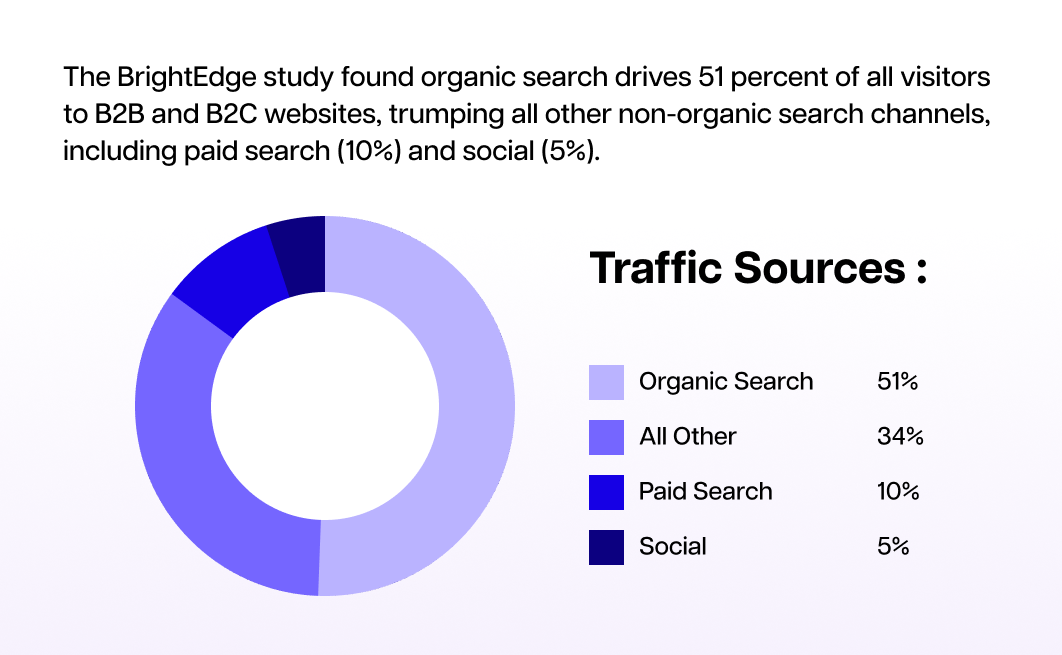
Content, in various forms, such as web pages, blogs, product descriptions, articles, images, and videos, is the key element for SEO. Without it, SEO would be akin to a ship without a sail — unable to navigate effectively. SEO and content are intertwined; they collaborate to match specific search queries with target keywords.
As in, the multitude of results you see when you search for “How Does SEO Work?” don’t appear through magic. There are SEO experts on the other end, assisting search engines in better understanding how to categorize content effectively.
What is Content Marketing?
Content marketing is precisely what it sounds like- employing content as a marketing tool. It serves as the cornerstone of various digital marketing campaigns. That blog post you published last week can find additional exposure on social media platforms, but the true driving force behind most content marketing strategies is the groundwork laid by SEO.
However, it’s crucial to understand that exceptional SEO doesn’t compensate for lackluster content. SEO isn’t a magical elixir that transforms subpar blogs and websites and makes them appear on the first page of search results.
Quality is just one of the significant elements search engines evaluate when looking at content. No matter how robust your SEO efforts may be, if your content marketing is filled with errors, inconsistencies, or lacks polish, it’s an uphill battle.
You need to create content tailored to your specific target audience — content that offers solutions or entertainment to those in search of it.
Now that we have an understanding of how these two techniques work together, let’s combine them!
Merging the Two: SEO-Driven Content Marketing
The debate isn’t about choosing between SEO or content marketing, but rather, how you can enhance the visibility of your already exceptional content through robust SEO strategies.
Enter SEO-driven content marketing.
It is a strategic approach that combines the power of SEO with content creation to enhance a brand’s online visibility and drive organic traffic. This methodology focuses on producing high-quality, relevant content that not only engages the target audience but also ranks favorably on search engine results pages (SERPs).
By aligning content with specific keywords and search queries, businesses can increase their chances of being discovered by potential customers.
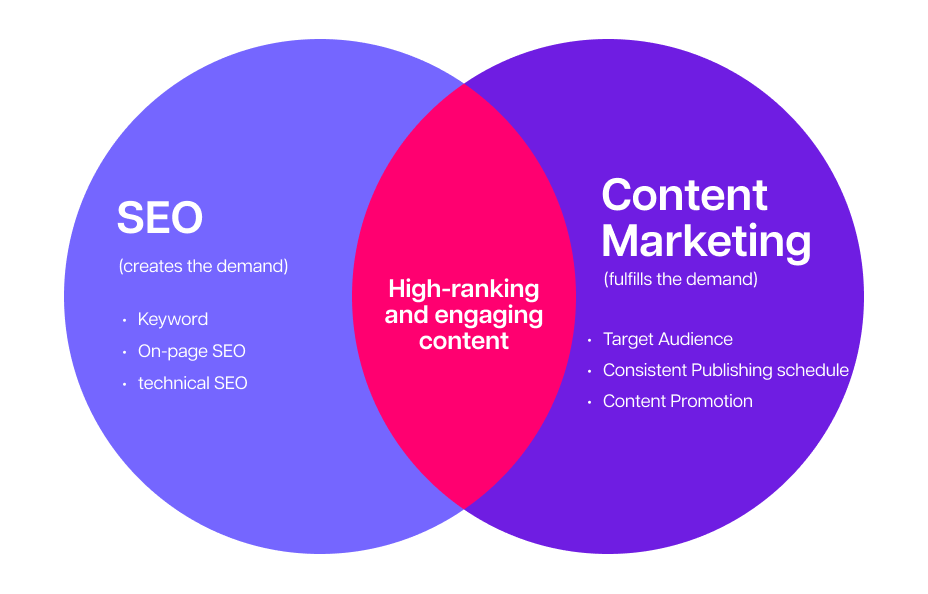
One noteworthy example of a company excelling in SEO-driven content marketing is HubSpot.
HubSpot consistently creates informative and educational content around topics related to inbound marketing, sales, email list segmentation, best practices in email design, and so on. By conducting thorough keyword research and crafting content that addresses the needs and pain points of its target audience, HubSpot has established itself as an authoritative source in the marketing space.
Now, content tailored to rank on search engines while fulfilling marketing objectives requires a careful balance. It’s not just about incorporating keywords but also about providing value and relevance to the audience.
For instance, if a company in the fitness industry wants to rank for the keyword “best home workout equipment,” they can create a comprehensive guide that not only highlights their products but also offers valuable tips and insights on building an effective home gym. This way, they cater to both search engine algorithms and the needs of potential customers.
Importance of SEO-Driven Content Marketing
One of the main benefits of employing SEO-driven content marketing is the substantial boost it provides to online visibility.
By aligning content with relevant keywords and search queries, businesses can climb the ranks in SERPs. This ensures that their content is more likely to be seen by their target audience. With effective SEO strategies in place, content is more likely to attract organic traffic over time. This means a steady stream of visitors who are genuinely interested in what the business has to offer.
It is important to note that SEO-driven content marketing goes beyond visibility; it focuses on creating meaningful connections with the audience.
Content that is optimized for search engines is also tailored to meet the needs and interests of the target audience. This ensures that users find the content valuable and relevant to their queries. When content consistently provides valuable information, it establishes the brand as an authority in its industry. This fosters trust among the audience, leading to stronger customer relationships.
Similarly, investing in this approach offers a cost-effective alternative to traditional advertising methods. Unlike paid advertising, which requires ongoing expenditure, content optimized for SEO can continue to attract organic traffic over an extended period. This leads to sustainable, long-term benefits for the business.
And while paid advertising certainly has its merits, a well-executed content marketing strategy driven by the best SEO practices can significantly reduce the reliance on costly paid advertising campaigns, making it a more budget-friendly option.
Building a Strong SEO-Driven Content Marketing Strategy
Follow this step-by-step holistic process to create content that not only ranks well but also resonates with your audience, ultimately driving success for your business.
1. Understand Your Audience
Before creating an SEO-driven content marketing strategy, you need to understand the target audience you’re aiming to hit.
Start by developing detailed buyer personas that represent your target audience segments. Establish audience segmentation based on different factors, like their purchasing behavior, historical purchases, demographics, interests, etc.
While creating your buyer persona, here are some of the things you need to consider:
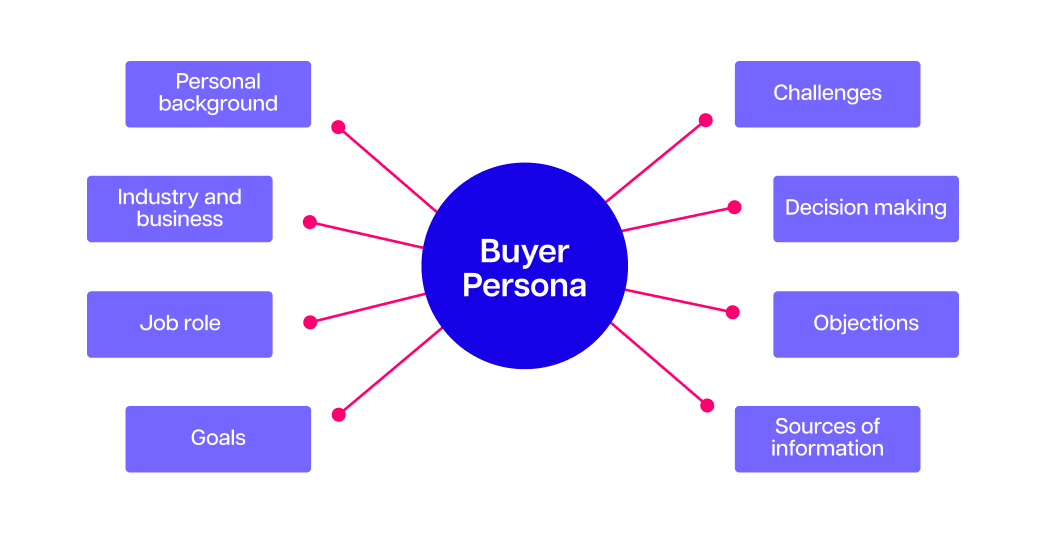
Conduct thorough research to identify the challenges, questions, and interests of your audience. This insight will serve as the foundation for creating content that addresses their concerns and provides value.
2. Keyword Research
Leverage powerful keyword research tools such as Google Keyword Planner, SEMrush, and Ahrefs to identify relevant and high-performing keywords for your content. These tools provide valuable data on search volume, competition, and keyword variations.
Dive deeper into long-tail keywords that reflect specific queries your audience might have.
Let’s take the example of Blue Apron, which provides meal kit delivery services. When they conduct keyword research, they might identify a broad keyword like “meal kit delivery.“
However, to refine their content strategy, they would dive deeper into long-tail keywords and search intent. They might discover specific queries like:
- “Quick and easy meal kits for busy parents”
“Vegetarian meal kits for two”
“Healthy and low-calorie meal options”
By understanding the search intent behind these long-tail keywords, Blue Apron can tailor their content accordingly. For example, they might create blog posts, recipes, or landing pages addressing these topics. This approach allows them to target a more specific audience and provide content that directly addresses their needs and interests.
3. High-Quality Content Creation
The next step is to craft high-quality content that offers genuine value to your target audience. Figure out what’s connecting with audiences and what’s not. Once you’ve got a good idea of your competitors’ targeting, aim to recreate that success with your upcoming content.
Like, who wouldn’t want to work with a company that serves as an inspiration for others?
A prime example is marketing expert Neil Patel, who creates high-quality content such as videos, blogs, and social media to share insights, educate, and express opinions on various marketing topics.
Your content strategy should have a mix of different content formats, including:
- Blog posts
- Real-life examples
- Detailed reports
- E-books
- Easy-to-read graphics
- Videos
- Online seminars
Be creative, and ensure the content is timely, informative, and relevant.
You can enhance the user experience by incorporating multimedia elements as it not only engages with the audience but also helps in conveying information effectively.
4. On-Page SEO Best Practices
Optimize title tags and meta descriptions to reflect the content accurately and include relevant keywords. Utilize headers (H1, H2, H3, etc.) to structure content for easy readability and SEO. Remember to include keywords in both headers and meta descriptions to signal the content’s relevance.
Link to other relevant pages within your website to provide additional context and guide users to related content. For example, if you run an e-commerce website selling shoes, a blog post about “Top Running Shoe Brands” will include internal links to specific product pages for each brand mentioned. Say, you might link “Nike” to the Nike product category page and “Adidas” to the Adidas product category page. This not only helps users find relevant products but also strengthens the internal linking structure of your website.
Additionally, ensure that URLs are concise, descriptive, and include relevant keywords.
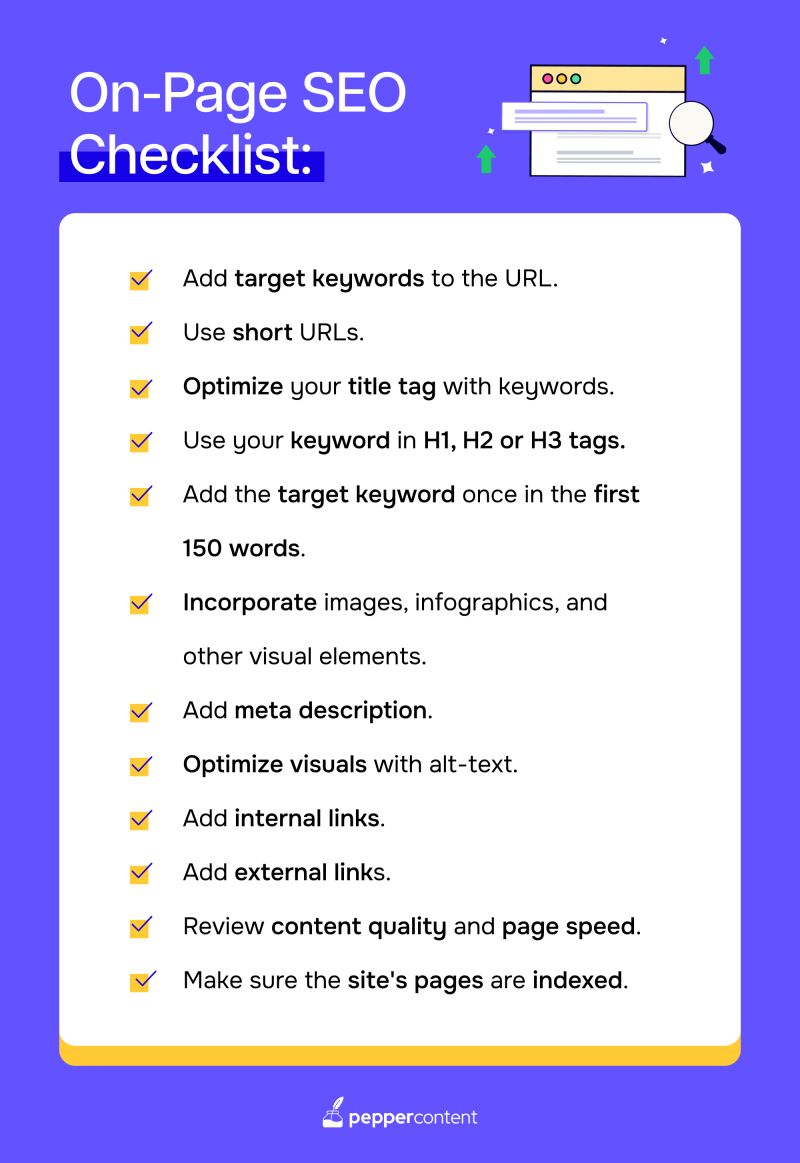
5. Content Promotion & Link Building
Leverage social media channels, such as LinkedIn, Instagram, and Twitter, to promote and distribute your content. This will not only help you engage with your audience but also encourage shares, comments, and interactions among them.
You can also collaborate with industry influencers, organizations, or authoritative websites through guest posting. This not only expands your reach but also helps in acquiring valuable backlinks that boost your content’s authority. Moreover, you can also create tailored email marketing campaigns to engage with your audience and build brand awareness effectively.
6. Continual Monitoring and Optimization
Once your strategy is up and running, it’s crucial to measure its effectiveness and optimize it for better results. You can regularly monitor the performance of your content using analytics tools such as Google Analytics and Google Search Console.
Here are some of the metrics you should focus on:
- Referral Rates
- Organic and Inorganic Page Views
- Social Media Engagement
- Revenue Generation
- Lead Generation
- Conversion Rates
Based on the insights gained from analytics, adapt and optimize your content marketing strategy. Fine-tune keyword targeting, content formats, and distribution channels to improve results over time. You can do this check every few weeks or a month to stay on top of your progress.

Challenges to Anticipate
When implementing a content marketing strategy driven by SEO, you can encounter several challenges. These challenges range from adapting to rapidly evolving SEO algorithms and differentiating content in a saturated online space to meeting the ever-growing expectations of users. Understanding and proactively addressing these challenges is essential for businesses to thrive in today’s competitive digital landscape.
Let’s take a look at some of these challenges that businesses must navigate to achieve success.
1. Constantly Evolving SEO Algorithms
SEO algorithms used by search engines (like Google or Microsoft Bing) are dynamic and frequently updated. Staying informed about these changes is crucial to maintain visibility and rankings. Failing to do so could result in a decline in search engine performance, potentially impacting the reach and exposure of a website or content.
In the fast-paced digital landscape, adaptability is key. When search engine algorithms evolve, businesses must realign their SEO strategies swiftly. This ensures that their content remains relevant and competitive in search results.
2. Saturation of Content Online
With an abundance of content available online, creating high-quality, unique, and valuable content is essential to stand out and capture the audience’s attention. Understanding your specific audience’s needs and tailoring content to address their pain points helps create content that resonates and sets itself apart.
3. Evolving User Expectations
Users now expect content that engages them actively, setting a higher bar for the kind of content they consume and interact with. Incorporating videos, interactive infographics, quizzes, and other multimedia formats can enhance user experience. These dynamic features not only capture attention but also provide an immersive experience. They encourage active participation, making the content more memorable and impactful.
You can also customize content to align with users’ specific preferences, behaviors, and demographics. Personalization can be achieved through targeted messaging, recommendation algorithms, and user-specific content recommendations.
By delivering content that resonates on a personal level, businesses can foster a stronger connection between the brand and its audience.
Final Thoughts
As the digital landscape continues to evolve rapidly, adapting and excelling in content marketing driven by SEO is more crucial than ever before. While challenges may arise in the form of evolving SEO algorithms, content saturation, and changing user expectations, these hurdles can be overcome with adaptability and creativity. By proactively addressing these challenges, businesses can thrive in the dynamic digital landscape, delivering valuable, impactful content to their target audience.
Remember, in a constantly evolving online world, agility and responsiveness are key to staying ahead of the curve!
If you’re seeking expert help in creating high-quality content that converts, Pepper Content is here to assist you — Book a demo now!
Latest Blogs
Explore how Google’s 2025 AI search updates triggered ranking chaos. Learn actionable strategies to adapt your SEO for AI Overviews, zero-click searches, and SERP volatility. Stay ahead now.
Learn how to rank on AI search engines like ChatGPT, Perplexity, and Gemini by optimizing your content for authority, structure, and relevance. Stay ahead in AI-driven search with this strategic guide.
Explore the best healthcare SEO services for your medical practice. Improve online visibility and effectively reach more patients in need of your services.
Get your hands on the latest news!
Similar Posts

Content Strategy
5 mins read
Choosing The Best Healthcare Marketing Agency For Effective Content Solutions

Content Marketing
4 mins read
Top 10 Agencies B2B SaaS Content Marketing for B2B Success

B2C Marketing
5 mins read